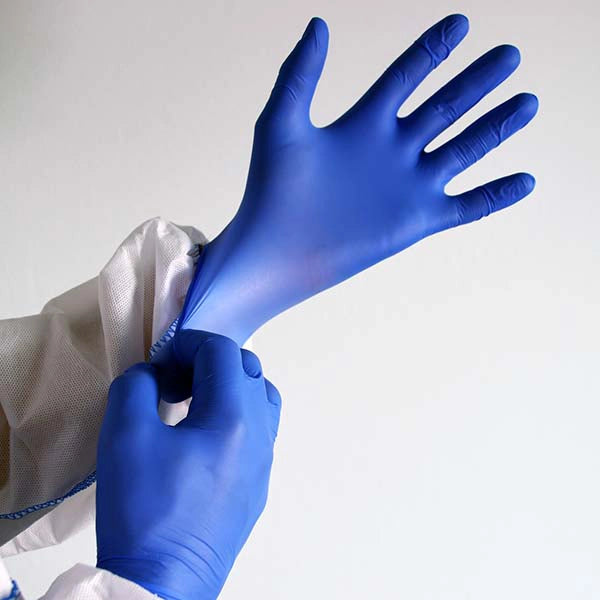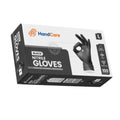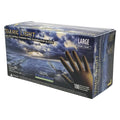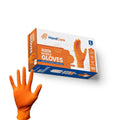First responders play a critical role in emergencies, putting their lives on the line to help and save others. Emergency service workers are faced with high-pressure and demanding environments - and having the best gear on hand can make all the difference when it comes to protecting themselves.
Disposable gloves are a priority for first responders to minimize risks for themselves. Offering superior protection, first responder gloves will help them avoid contact with bodily fluids that may contain disease-causing microorganisms and prevent exposure to infection.
Disposable nitriles are the best for responders because they are impervious to body fluids. The material is also ideal for handling chemical-related burns and chemical spills, making them the best alternative to latex gloves. The best gloves for responders range from 4 mil to 8 mil in thickness - providing durability without compromising on dexterity.
Choosing the best gloves can be daunting - whether you're an EMT, paramedic, or police. That's why we've come up with this guide, considering the unique needs of these professionals.
At a glance:
- Types of First Responders' Gloves
- Thickness and Fit
-
9 Best EMS Gloves
- HandCare Black Nitrile Gloves - Exam Grade, Powder Free
- GripProtect® Precise Black Nitrile Exam Gloves
- SereneLife SLGLVNIT100LG Nitrile Disposable Gloves
- O'WELL 100 Nitrile Medical Examination Gloves
- PEIPU Nitrile and Vinyl Disposable Gloves
- FirstCare First Responders EMS EMT Blue Nitrile Gloves
- Sempermed Sempershield high-risk nitrile gloves
- HALYARD* Nitrile gloves
- Safecare Medical Grade 6.5 Mil Nitrile Gloves
- Final Words
Types of First Responders' Gloves

EMT gloves are made in a range of different materials, with the most popular being latex, vinyl, and nitrile gloves. Each offers a high level of protection, lowers your risks of exposure and infections, and helps you to protect yourself and your patient while you do your job.
Nitrile Gloves
Nitrile gloves are best known for their resistance to different chemicals, punctures, and abrasions. They are a popular choice for first responders dealing with hazardous materials - as they offer strong protection from chemical exposure. Nitrile gloves are latex-free reducing the risk of allergic reactions.
Latex Gloves
Latex gloves are generally the most commonly used gloves in the medical world. They are known for their superior fit, comfort, and tactile sensitivity - as well as protecting against bodily fluids. Latex gloves are best used for medical tasks that require precision, however, you or your patient may suffer from a latex allergy.
Vinyl Gloves
Vinyl gloves are the cheapest option of the three, however, they are best used in low-risk tasks and situations as they don't offer the same level of protection as other first responder gloves. These gloves are more susceptible to punctures and sensitive to chemicals making them best suited to non-medical environments.
Thickness and Fit
Gloves come in a wide range of sizes, thicknesses, and fits - and what works best for you depends on the job at hand. Generally the thicker the glove the more protection provided. Standard thickness gloves are suitable for routine medical and EMS tasks, well as extra thick gloves are needed for high-risk situations. A thicker glove will protect against hazardous materials, punctures from sharp objects, and all bodily fluids.
The fit of a glove is critical for both comfort and dexterity. Over or undersized gloves can affect your ability to perform tasks effectively, decrease durability, and even cause discomfort. When choosing the size size glove for you, you should be looking for a snug fit - a snug fit will ensure dexterity and prevent your gloves from slipping off during the procedure.
9 Best EMS Gloves in 2025
1. HandCare Black Nitrile Gloves - Exam Grade, Powder Free
Emergency medical service providers (EMS), police, and other rescue experts should pay particular attention when choosing the best protective glove type because they can come in contact with sharp objects, chemicals, and body fluids, as well as being exposed to disease and infection.
Working in an emergency environment, the biggest thing you should be looking for is excellent barrier protection. HandCare Black Nitrile Gloves offers protection to this group of professionals.
👉 Shop HandCare Black Nitrile Gloves and save up to 50% today
These glove types have no latex and are resistant to tears and punctures, making them ideal for those with latex allergies for both you and your patients. Additionally, they are powder-free and have a thickness of 5.5 mil and a length of 9.5 inches. Also, the materials used to manufacture adhere to federal regulations for quality.
Key Features:
- 9.5 inch in length
- Powder-free
- 5.5 mil thickness
- Textured for grip
- Rolled cuff
2. HandCare Blue Nitrile Gloves - Exam Grade, Powder Free (4 Mil)
These gloves are a versatile choice for various emergency applications. Their 4-mil thickness offers a balance between sensitivity and durability, making them ideal for tasks requiring precision. They are latex-free, catering to individuals with latex allergies.
👉 Shop HandCare Blue Nitrile Gloves and save up to 50% today
Key Features:
-
Powder-free
-
Latex-free
-
Blue color
-
Comfortable fit for extended use
3. Dark Light Black Nitrile Gloves - Exam Grade, Powder Free (9 Mil)
Designed for high-risk scenarios, these gloves provide superior protection with their extra thickness. The 9-mil construction ensures resistance to punctures and chemicals, making them suitable for industrial and emergency medical use.
👉 Shop Dark Light Black Nitrile Gloves and save up to 50% today
Key Features:
-
9-mil thickness
-
Powder-free
-
Textured for enhanced grip
-
Superior protection for high-risk environments
4. HandCare Orange Nitrile Gloves - Powder Free (8 Mil)
Highly visible due to their bright orange color, these gloves are perfect for first responders needing durability and visibility in emergencies. They are powder-free and thick enough to handle demanding tasks while maintaining flexibility.
👉 Shop Orange Nitrile Gloves and save up to 50% today
Key Features:
-
Powder-free
-
Bright orange for visibility
-
Textured for a secure grip
-
Extended cuff for added protection
5. PEIPU Nitrile and Vinyl Disposable Gloves
PEIPU disposable gloves are made from a blend of nitrile and vinyl. They offer a firm grip, enhanced comfort, and optimal sensitivity. Also, they are powder and latex-free.
PEIPU gloves offer excellent protection against gases, liquids, glass, grease, and sharp objects.
Emergency responders can wear these gloves to minimize skin contact with the outside world, thus enhancing personal hygiene and health. The box contains 100 gloves. PEIPU gloves come in different sizes; therefore, you can get your ideal size.
Key Features:
- Latex and powder-free
- Abrasion-resistant
- Comfortable
- 4mil thick
- Ambidextrous
- Acid and alkali resistant
6. FirstCare First Responders EMS EMT Blue Nitrile Gloves
FirstCare First Responders Gloves come with pre-printed writing templates to help medics during emergencies. With these templates, emergency responders can record the patient's vitals without the need for a laptop or notebook.
The templates help save time when offering emergency care to patients. Each box contains 100 gloves. These gloves are available in S, M, L, and XL sizes.
Key Features:
- Available in four sizes
- Latex-free
- Powder-free
- Pre-printed notes template
- Ambidextrous gloves
7. Sempermed Sempershield High-Risk Nitrile Gloves
These gloves are designed for high-risk applications in which safety and applications are mandatory. The Sempermed Sempershield includes a textured surface for a secure grip.
The gloves do not have natural rubber, thus they are ideal for latex sensitivity.
Also, they include extra thickness and an extended cuff to offer additional protection for the lower forearm and wrist. The gloves are also chemical resistant and will protect against different chemicals.
Key Features:
- Powder-free
- 50 gloves per box
- Ambidextrous
- Textured surface
- Beaded cuff
8. HALYARD* Nitrile gloves
The Halyard nitrile gloves undergo different tests to evaluate their usability for various procedures and environments. These tests include water leak tests, chemotherapy drug testing, and viral penetration testing.
The gloves are thick enough to offer the best protection, comfortable and tactile sensitivity. Halyard gloves are powder-free; thus, they adhere to the FDA January 18, 20173 standards for powder-free gloves. Also, they are long enough to protect your wrist and arms.
Key Features:
- Adhere to ASTM and NFPA standards
- Extended cuff
- Powder-free
- Durable
- Normalized thickness
- Puncture resistant
9. Safecare Medical Grade 6.5 Mil Nitrile Gloves (9.5" cuff)
The Safecare 6.5mil nitrile gloves are made per USDA and FDA specifications. They meet tear and leak resistance standards. These gloves offer enhanced barrier protection against germs and the outside environment, making them suitable for first responders.
Safecare gloves are made from 100% nitrile butadiene rubber, which is powder and latex-free. They are manufactured using the latest technology to boost their tensile strength. In addition, you can wear gloves for extended periods.
Key Features:
- Powder and latex-free
- 9.5" beaded cuff
- 6.5 mil thickness
- Medical grade
- Bar-coded boxes and cartons
- Safety-sealed packaging
Why Are Latex Gloves Used in First Aid?
Latex gloves are commonly used in first aid due to their superior ability to protect against blood, bodily fluids, and pathogens, reducing the risk of infection and cross-contamination.
Their snug fit and elasticity allow first responders to maintain excellent dexterity, making it easier to perform delicate procedures such as dressing wounds or administering injections.
Apart from their functionality, latex gloves are widely favored because they are cost-effective and readily available, making them a practical choice for first aid kits and emergency medical supplies.
However, it is important to note that some individuals may experience allergic reactions to latex, which has led to the increased use of alternatives like nitrile gloves in situations where latex sensitivity is a concern.
Despite this limitation, latex gloves remain a trusted option in many first aid scenarios due to their reliability and versatility.
Where to Buy EMS Gloves?
When shopping for disposable gloves, first responders should pay special attention to the material, size, color, and extra protection features.
The gloves should protect from exposure to pathogens in blood fluids and toxic drugs and chemicals that they may encounter in the line of duty.
With suitable gloves, first responders can do their work without worrying about injury or infection.
Shop our special collection of EMS Gloves on gloves.com and save up to 50% today!








